英语常见时态标志词语
- 格式:doc
- 大小:52.00 KB
- 文档页数:2
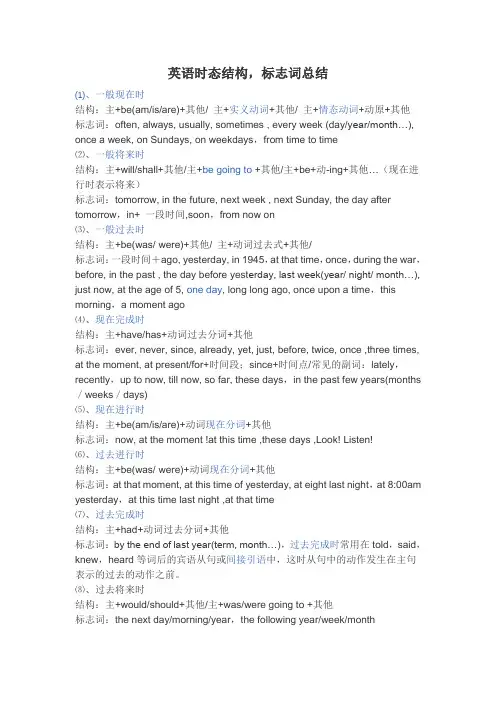
英语时态结构,标志词总结⑴、一般现在时结构:主+be(am/is/are)+其他/ 主+实义动词+其他/ 主+情态动词+动原+其他标志词:often, always, usually, sometimes , every week (day/y ear/month…), once a week, on Sundays, on weekdays,from time to time⑵、一般将来时结构:主+will/shall+其他/主+be going to +其他/主+be+动-ing+其他…(现在进行时表示将来)标志词:tomorrow, in the future, next week , next Sunday, the day after tomorrow,in+ 一段时间,soon,from now on⑶、一般过去时结构:主+be(was/ were)+其他/ 主+动词过去式+其他/标志词:一段时间+ago, yesterday, in 1945,at that time,once,during the war,before, in the past , the day before yest erday, last week(year/ night/ month…), just now, at the age of 5, one day, long long ago, once upon a time,this morning,a moment ago⑷、现在完成时结构:主+have/has+动词过去分词+其他标志词:ever, never, since, already, yet, just, before, twice, once ,three times, at the moment, at present/for+时间段;since+时间点/常见的副词:lately,recently,up to now, till now, so far, these days,in the past few years(months /weeks/days)⑸、现在进行时结构:主+be(am/is/are)+动词现在分词+其他标志词:now, at the moment !at this time ,these days ,Look! Listen!⑹、过去进行时结构:主+be(was/ were)+动词现在分词+其他标志词:at that moment, at this time of yesterday, at eight last night,at 8:00am yesterday,at this time last night ,at that time⑺、过去完成时结构:主+had+动词过去分词+其他标志词:by the end of last year(term, month…),过去完成时常用在told,said,knew,heard等词后的宾语从句或间接引语中,这时从句中的动作发生在主句表示的过去的动作之前。
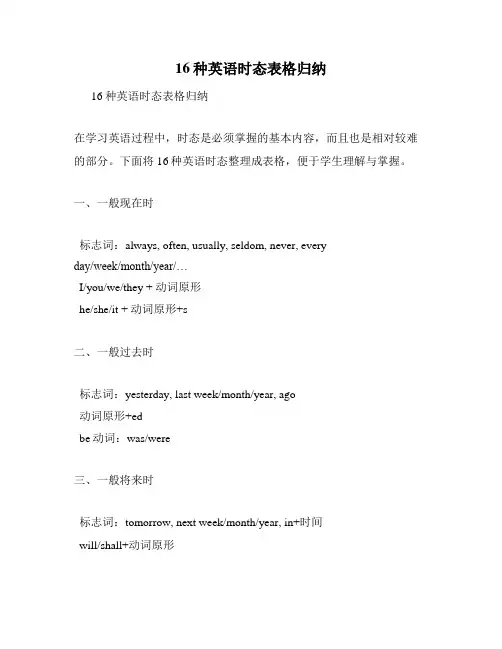
16种英语时态表格归纳16种英语时态表格归纳在学习英语过程中,时态是必须掌握的基本内容,而且也是相对较难的部分。
下面将16种英语时态整理成表格,便于学生理解与掌握。
一、一般现在时标志词:always, often, usually, seldom, never, everyday/week/month/year/…I/you/we/they + 动词原形he/she/it + 动词原形+s二、一般过去时标志词:yesterday, last week/month/year, ago动词原形+edbe动词:was/were三、一般将来时标志词:tomorrow, next week/month/year, in+时间will/shall+动词原形四、现在进行时标志词:now, at the moment, right now, currently am/is/are+现在分词五、过去进行时标志词:at+时间,when, whilewas/were+现在分词六、将来进行时标志词:at+时间will/shall+be+现在分词七、现在完成时标志词:ever, never, already, yet, justhave/has+过去分词八、过去完成时标志词:before, by the timehad+过去分词九、将来完成时标志词:by+时间will/shall+have+过去分词十、一般过去时被动语态标志词:被动语态was/were+过去分词十一、现在完成时被动语态标志词:被动语态have/has+been+过去分词十二、过去完成时被动语态标志词:被动语态had+been+过去分词十三、一般将来时被动语态标志词:被动语态will/shall+be+动词过去分词十四、现在进行时被动语态标志词:被动语态am/is/are+being+过去分词十五、过去进行时被动语态标志词:被动语态was/were+being+过去分词十六、将来进行时被动语态标志词:被动语态will/shall+be+being+过去分词以上是英语16种时态的表格汇总,当然还有很多语法细节需要注意,而且有些时态在实际使用过程中还会存在一些变化。
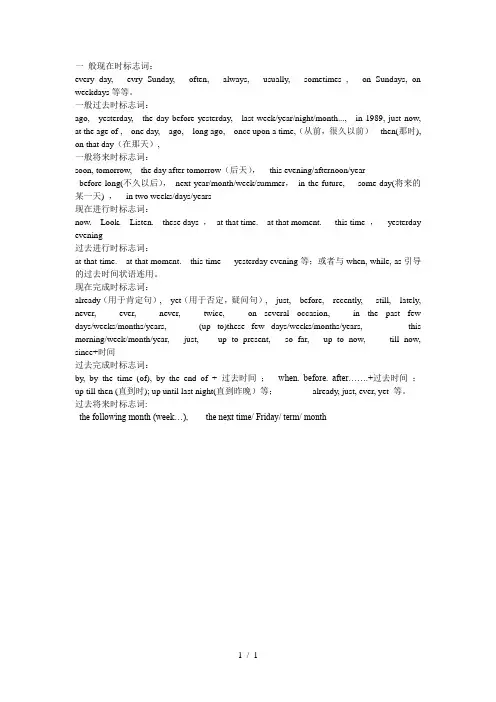
一般现在时标志词:every day, evry Sunday, often, always, usually, sometimes , on Sundays, on weekdays等等。
一般过去时标志词:ago, yesterday, the day before yesterday, last week/year/night/month..., in 1989, just now, at the age of , one day, ago, long ago, once upon a time,(从前,很久以前)then(那时), on that day(在那天),一般将来时标志词:soon, tomorrow, the day after tomorrow(后天),this evening/afternoon/yearbefore long(不久以后),next year/month/week/summer,in the future, some day(将来的某一天) ,in two weeks/days/years现在进行时标志词:now. Look. Listen. these days ,at that time. at that moment. this time ,yesterday evening过去进行时标志词:at that time. at that moment. this time yesterday evening等;或者与when, while, as引导的过去时间状语连用。
现在完成时标志词:already(用于肯定句), yet(用于否定,疑问句), just, before, recently, still, lately, never, ever, never, twice, on several occasion, in the past few days/weeks/months/years, (up to)these few days/weeks/months/years, this morning/week/month/year, just, up to present, so far, up to now, till now, since+时间过去完成时标志词:by, by the time (of), by the end of + 过去时间;when. before. after…….+过去时间;up till then (直到时); up until last night(直到昨晚)等;already, just, ever, yet 等。
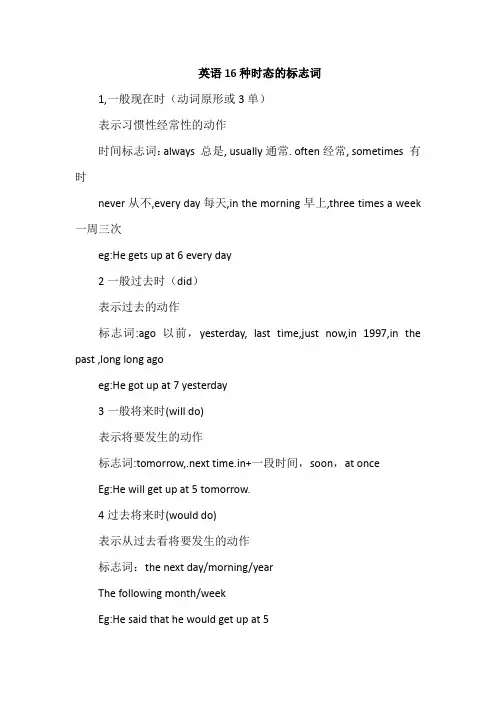
英语16种时态的标志词1,一般现在时(动词原形或3单)表示习惯性经常性的动作时间标志词:always 总是, usually通常. often经常, sometimes 有时never从不,every day每天,in the morning早上,three times a week 一周三次eg:He gets up at 6 every day2一般过去时(did)表示过去的动作标志词:ago以前,yesterday, last time,just now,in 1997,in the past ,long long agoeg:He got up at 7 yesterday3一般将来时(will do)表示将要发生的动作标志词:tomorrow,.next time.in+一段时间,soon,at onceEg:He will get up at 5 tomorrow.4过去将来时(would do)表示从过去看将要发生的动作标志词:the next day/morning/yearThe following month/weekEg:He said that he would get up at 5进行时,四种5现在进行时(am/is/are doing)表示此时此刻正在进行的动作标志词:now,look,listen,at 1 o’clockEg:He is having breakfast now6过去进行时(was/were doing)表示过去某一时刻正在进行的动作标志词:this time yesterday,at that time, then, 具体的时间点Eg:I was doing my homework at 8 yesterday7将来进行时(will be doing)表示将来某一时刻正在进行的动作标志词:this time tomorrow,at that time , 具体的时间点Eg:I will having a meeting at 8 next Monday8过去将来进行时(would be doing)表示从过去某一时间看,将要进行的动作Eg He asked me not to come at 8 because he would be having a meeting then完成时,四种9现在完成时(have/has done)表示到说话时,已经完成的动作标志词:already已经,recently最近,for+时间段,Eg:I have already finished my homework10 过去完成时(had done)表示过去某一时刻说话前,已经完成的动作标志词:before+过去的时间点,when引导的状语从句,by the end of +过去的时间Eg:He said that he had finished his homework11将来完成时(will have done)表示某个时间点之前要完成的动作Eg :we will have finished Book One by the end of this term.12过去将来完成时(would have done)表示从过去某个时间看,将要再过去某个时间完成的动作标志词:by the end of +将来的时间,before +将来的时间,。
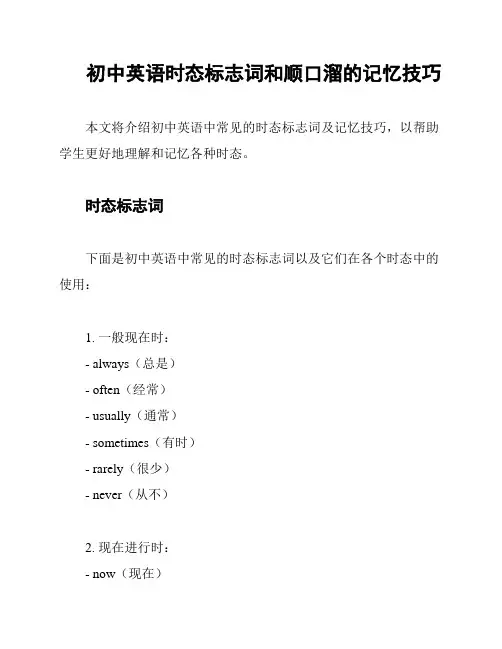
初中英语时态标志词和顺口溜的记忆技巧本文将介绍初中英语中常见的时态标志词及记忆技巧,以帮助学生更好地理解和记忆各种时态。
时态标志词下面是初中英语中常见的时态标志词以及它们在各个时态中的使用:1. 一般现在时:- always(总是)- often(经常)- usually(通常)- sometimes(有时)- rarely(很少)- never(从不)2. 现在进行时:- now(现在)- at the moment(此刻)- currently(目前)- at present(目前)- right now(立刻)3. 一般过去时:- yesterday(昨天)- last week(上周)- in 1999(在1999年)- a few minutes ago(几分钟前)- when I was a child(我小的时候)4. 过去进行时:- at that time(那个时候)- while(当...的时候)- when(当...的时候)- as(当...的时候)- during(在...期间)5. 一般将来时:- tomorrow(明天)- next week(下周)- in the future(将来)- soon(很快)- one day(有一天)6. 将来进行时:- this time tomorrow(明天这个时候)- in a week(一周后)- at this time next year(来年此时)- by the end of next month(到下个月底)记忆技巧记忆时态标志词可以使用以下顺口溜来帮助你:一般现在时要记好,总是often, 通常usually.现在进行时,此刻用,now, at the moment记心头.一般过去时记起来,昨天yesterday, 上周last week.过去进行时多用when,at that time, while来记存.一般将来时记清楚,明天tomorrow, 下周next week.将来进行时用点时刻,this time tomorrow, 一周后in a week.以上是初中英语时态标志词及顺口溜的记忆技巧,希望对你有帮助!。
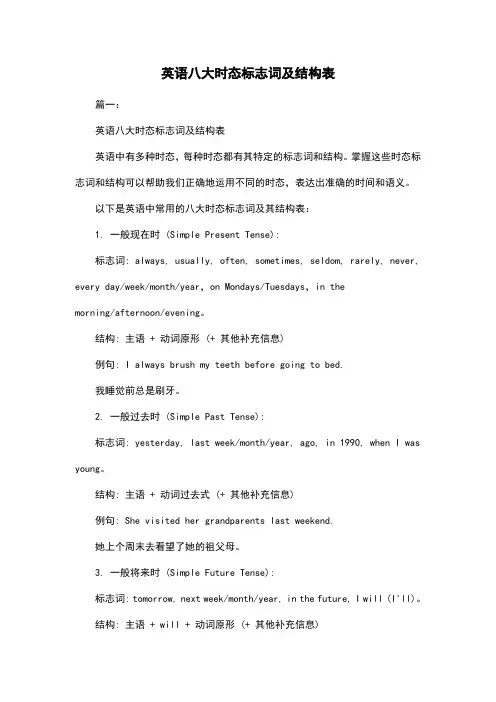
英语八大时态标志词及结构表篇一:英语八大时态标志词及结构表英语中有多种时态,每种时态都有其特定的标志词和结构。
掌握这些时态标志词和结构可以帮助我们正确地运用不同的时态,表达出准确的时间和语义。
以下是英语中常用的八大时态标志词及其结构表:1. 一般现在时 (Simple Present Tense):标志词: always, usually, often, sometimes, seldom, rarely, never, every day/week/month/year,on Mondays/Tuesdays,in themorning/afternoon/evening。
结构: 主语 + 动词原形 (+ 其他补充信息)例句: I always brush my teeth before going to bed.我睡觉前总是刷牙。
2. 一般过去时 (Simple Past Tense):标志词: yesterday, last week/month/year, ago, in 1990, when I was young。
结构: 主语 + 动词过去式 (+ 其他补充信息)例句: She visited her grandparents last weekend.她上个周末去看望了她的祖父母。
3. 一般将来时 (Simple Future Tense):标志词: tomorrow, next week/month/year, in the future, I will (I'll)。
结构: 主语 + will + 动词原形 (+ 其他补充信息)例句: We will go shopping tomorrow.我们明天去购物。
4. 现在进行时 (Present Continuous Tense):标志词: now, at the moment, currently, right now, look!。
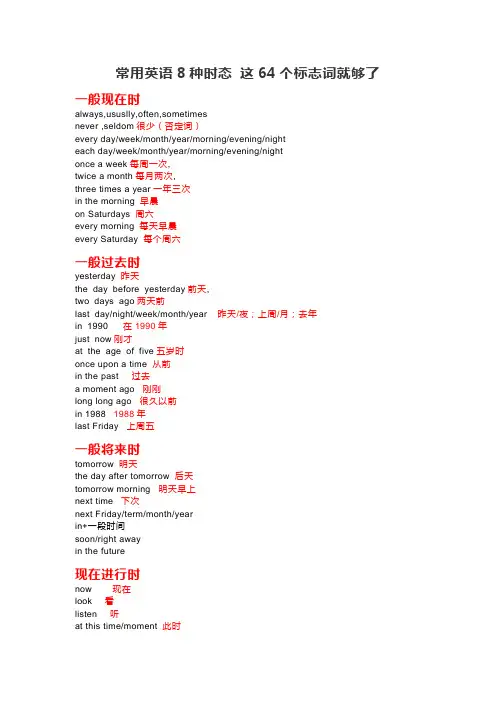
常用英语8种时态这64个标志词就够了一般现在时always,ususlly,often,sometimesnever ,seldom很少(否定词)every day/week/month/year/morning/evening/nighteach day/week/month/year/morning/evening/nightonce a week每周一次,twice a month每月两次,three times a year一年三次in the morning 早晨on Saturdays 周六every morning 每天早晨every Saturday 每个周六一般过去时yesterday昨天the day before yesterday前天,two days ago两天前last day/night/week/month/year 昨天/夜;上周/月;去年in 1990 在1990年just now刚才at the age of five五岁时once upon a time 从前in the past 过去a moment ago 刚刚long long ago 很久以前in 1988 1988年last Friday 上周五一般将来时tomorrow 明天the day after tomorrow 后天tomorrow morning 明天早上next time 下次next Friday/term/month/yearin+一段时间soon/right awayin the future现在进行时now 现在look 看listen 听at this time/moment此时these days 这些天at present 现在现在完成时already/yetjustnevereverfor+一段时间since+时间一点so far/up to now 到目前为止in the past three years 在过去3年里过去完成时by+过去时间点by the timeby thenby the end of last yearbefore+过去时间点up till+过去时间点up till then过去进行时at that timeat that momentyesterday evening过去将来时the following monththe next timethe next fridaythe next term。
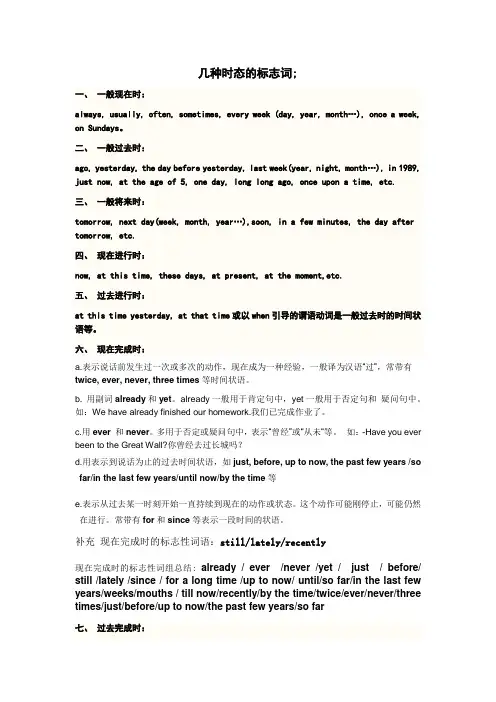
几种时态的标志词;一、一般现在时:always, usually, often, sometimes, every week (day, year, month…), once a week, on Sundays。
二、一般过去时:ago, yesterday, the day before yesterday, last week(year, night, month…), in 1989, just now, at the age of 5, one day, long long ago, once upon a time, etc.三、一般将来时:tomorrow, next day(week, month, year…),soon, in a few minutes, the day after tomorrow, etc.四、现在进行时:now, at this time, these days, at present, at the moment,etc.五、过去进行时:at this time yesterday, at that time或以when引导的谓语动词是一般过去时的时间状语等。
六、现在完成时:a.表示说话前发生过一次或多次的动作,现在成为一种经验,一般译为汉语“过”,常带有twice, ever, never, three times等时间状语。
b. 用副词already和yet。
already一般用于肯定句中,yet一般用于否定句和疑问句中。
如:We have already finished our homework.我们已完成作业了。
c.用ever和never。
多用于否定或疑问句中,表示“曾经”或“从未“等。
如:-Have you ever been to the Great Wall?你曾经去过长城吗?d.用表示到说话为止的过去时间状语,如just, before, up to now, the past few years /so far/in the last few years/until now/by the time等e.表示从过去某一时刻开始一直持续到现在的动作或状态。
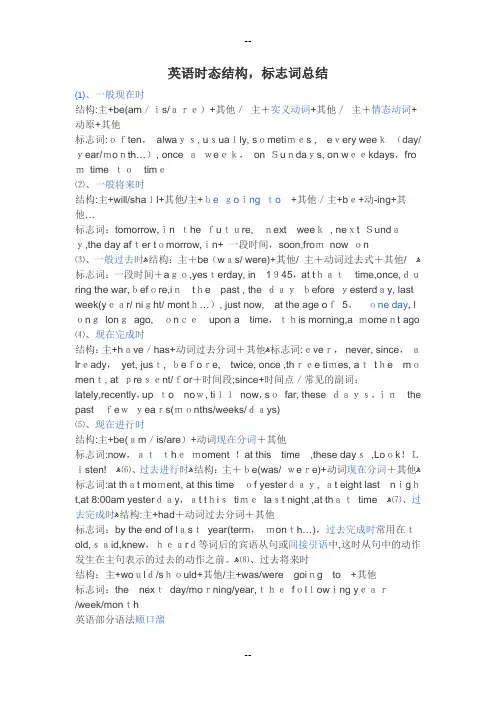
英语时态结构,标志词总结⑴、一般现在时结构:主+be(am/is/are)+其他/主+实义动词+其他/主+情态动词+动原+其他标志词:often,always, usually, sometimes ,every week(day/year/month…), once aweek,on Sundays, on weekdays,fro mtime totime⑵、一般将来时结构:主+will/shall+其他/主+be going to+其他/主+be+动-ing+其他…标志词:tomorrow,in the future,next week, next Sunday,the day after tomorrow,in+ 一段时间,soon,fromnow on⑶、一般过去时ﻫ结构:主+be(was/ were)+其他/ 主+动词过去式+其他/ﻫ标志词:一段时间+ago,yesterday, in1945,at thattime,once,during the war,before,inthe past , the daybefore yesterday, last week(year/ night/ month…), just now,at the age of5,one day, l onglongago,onceupon a time,this morning,a moment ago ⑷、现在完成时结构:主+have/has+动词过去分词+其他ﻫ标志词:ever,never, since,already,yet, just, before,twice, once ,three times, atthe moment, at present/for+时间段;since+时间点/常见的副词:lately,recently,up to now, tillnow,sofar, these days,inthe pastfewyears(months/weeks/days)⑸、现在进行时结构:主+be(am/is/are)+动词现在分词+其他标志词:now,atthemoment !at this time,these days,Look!Listen!ﻫ⑹、过去进行时ﻫ结构:主+be(was/ were)+动词现在分词+其他ﻫ标志词:at that moment, at this timeof yesterday, at eight last night,at 8:00am yesterday,at thistimelast night ,at thattimeﻫ⑺、过去完成时ﻫ结构:主+had+动词过去分词+其他标志词:by the end of lastyear(term,month…),过去完成时常用在told,said,knew,heard等词后的宾语从句或间接引语中,这时从句中的动作发生在主句表示的过去的动作之前。

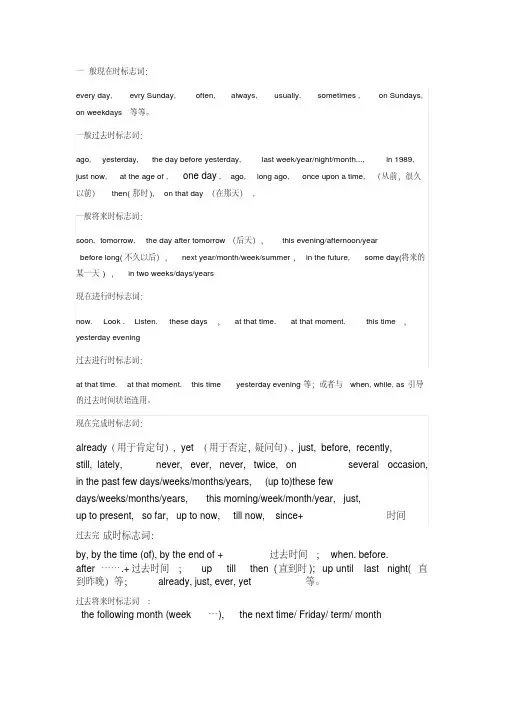
一般现在时标志词:every day, evry Sunday, often, always, usually, sometimes , on Sundays,on weekdays等等。
一般过去时标志词:ago, yesterday, the day before yesterday, last week/year/night/month..., in 1989,just now, at the age of , one day, ago, long ago, once upon a time,(从前,很久以前)then(那时), on that day(在那天),一般将来时标志词:soon, tomorrow, the day after tomorrow(后天),this evening/afternoon/yearbefore long(不久以后),next year/month/week/summer,in the future, some day(将来的某一天) ,in two weeks/days/years现在进行时标志词:now. Look. Listen. these days ,at that time. at that moment. this time ,yesterday evening过去进行时标志词:at that time. at that moment. this time yesterday evening等;或者与when, while, as引导的过去时间状语连用。
现在完成时标志词:already(用于肯定句), yet(用于否定,疑问句), just, before, recently,still, lately, never, ever, never, twice, on several occasion, in the past few days/weeks/months/years, (up to)these fewdays/weeks/months/years, this morning/week/month/year, just,up to present, so far, up to now, till now, since+时间过去完成时标志词:by, by the time (of), by the end of + 过去时间; when. before. after…….+过去时间; up till then (直到时); up until last night(直到昨晚)等; already, just, ever, yet 等。
八种时态基本结构与标志词1、一般现在时:动词原形或三单(注意三单变化)含义:①现阶段通常发生②客观真理③状语从句表将来(主将从现)标志:always、usually、 often、sometimes、hardly ever、seldom、every day、in the morning (afternoon …)、on Sundays、once a week、from time to time、at times、once in a while等例子:We go to school at six forty every day.My brother reads a book once a week.2、一般过去时:动词过去式(注意过去式变化)含义:过去一次性发生了或经常发生的动作标志: yesterday、last week、three days ago、the day before yesterday、in 1990 、in the 1930s、just now、those days、the other day、once upon a time、at birth、at the age of、one day、recently、when引导表过去的从句等例子:I finished my work yesterday.He went to New York ten days ago.3、现在进行时:am/ is/ are + doing (注意V-ing 变化)含义:此刻或现阶段正在发生的动作(注意:be always doing 表达抱怨或赞扬语气,不表示正在发生的动作)标志:Look! Listen! now、right now、at the moment\ time、at this moment\ timeat present 、these days、It’s six o’clock..、Where is your father?例子:Look! The boy is playing with a cat.It’s eight o’clock . The Smiths are watching TV in the living room.4、过去进行时:was/ were + doing含义:过去某一时刻或某阶段正在进行的动作标志:at six yesterday morning、 at this time yesterday、at that moment\time、thenfrom 7 to 9 yesterday morning、the whole morning last Sunday、when和while引导表过去的句子例子: He was taking a shower at 11 last night .They were cooking when the bell rang.(= While they were cooking, the bell rang.)5、现在完成时 : have/ has + done (注意过去分词变化、三大区分)(1)影响类含义:过去发生,对现在有影响标志:already (“已经”用于肯定句的中间和末尾处)yet (“已经”用于疑问句的末尾处 / “还”用于否定句的末尾处)never (“从不”用于中间处)ever (“曾经”用于疑问句和肯定句的中间处)just (“刚刚”用于中间处)before ("之前" 用于句尾)once/ twice/ three times...例子:I have just cleaned my clothes. 我刚洗过衣服。
常见时态标志词常见的时态标志词包括:1. 一般现在时:do/does(被动:is/am/are done),常用于描述现阶段经常发生的动作或存在的状态,如“We go to school at six forty every day.”“My brother reads a book once a week.”2. 现在进行时:am/is/are+doing,常用于描述正在进行的动作,如“Look! He is running now.”3. 一般将来时:will do,常用于描述将要发生的动作或存在的状态,如“I will call you tomorrow.”4. 过去进行时:was/were+doing,常用于描述过去某个时刻正在进行的动作,如“He was playing basketball at 5:00 yesterday afternoon.”5. 现在完成时:have/has+done,常用于描述已经完成的动作或存在的状态,如“I have finished my homework.”6. 过去完成时:had+done,常用于描述过去的某个时刻之前已经完成的动作,如“By the end of last year, they had built many new houses.”7. 过去将来时:would do,常用于描述过去的某个时刻预测未来的动作或状态,如“He said he would go to New York next year.”8. 过去完成进行时:had been doing,常用于描述过去的某个时刻之前一直在进行的动作,如“They had been waiting for the bus for half an hour before it arrived.”这些时态标志词可以帮助我们更好地理解和使用英语中的时态,在不同的语境中表达准确的时间关系和动作状态。
1现在完成时的词语标志,遇到这样的词一般用完成时2一些其他时态的标志词语现为你提供如下八种时态常用的标志词。
1、一般现在时表示:现阶段经常发生的动作或存在的状态标志: often、usually、always、sometimes、every day、in the morning (afternoon …)、on Sundays, once a week等例子:We go to school at six forty every day.My brother reads a book once a week.2、一般将来时表示:将要发生的动作或存在的状态标志:tomorrow、next week、this month、in an hour、the day after tomorrow 等例子:He will go to see a doctor tomorrow.I am going to play basketball next week..She is coming back in an hour.3、一般过去时表示:过去发生的动作或存在的状态标志: yesterday、last week、three days ago、the day before yesterday, in 1990 等例子:I finished my work yesterday.He went to New York ten days ago.4、现在进行时表示:现在正在进行的动作标志:now、Look! Listen! It’s six o’clock..例子:Look! The boy is playing with a cat.It’s eight o’clock . The Smiths are watching TV in the living room.5、过去进行时表示:过去某个时刻正在进行的动作标志:at six yesterday morning、from 7 to 9 yesterday morning 、this time yesterday、也可用在when和while引导的从句例子: He was taking a shower at 11 last night .They were cooking when the bell rang.(= While they were cooking, the bell rang.)6、现在完成时结构: have / has + 动词过去分词(一般+ed , 特殊见不规则表)表示:1)表示过去发生或完成的某一动作对现在造成的影响或结果。
英语八大时态标志词及结构表篇一:英语八大时态标志词及结构表正文:英语中存在八大时态,分别是:过去时、现在时、将来时、过去将来时、现在进行时、将来进行时、过去进行时、现在完成时和未来完成时。
这些时态的不同表达方式和用法,对于英语写作和口语表达都是非常重要的。
本文将介绍这些时态的标志词和结构表,帮助学习者更好地理解和掌握这些时态。
1. 过去时过去时通常用“态”或“ed”表示,表示动作或状态发生在过去。
标志词包括:- was(过去分词):表示动作或状态发生在过去某个时间。
- are(过去分词):表示动作或状态发生在过去。
- was/are(过去分词):表示动作或状态发生在过去的某个时刻。
结构表:| 主语 | 谓语动词 | 时态标志词 || --- | --- | --- || I | I was | was/are || you | you are | are || he/she/it | he/she/it was | was/are || we | we are | are || they | they were | were/are |2. 现在时现在时通常用“态”或“ing”表示,表示动作或状态现在正在进行。
标志词包括:- am/is(现在分词):表示动作或状态现在正在进行。
- are(现在分词):表示动作或状态现在正在进行。
- was/are(现在分词):表示动作或状态现在正在进行。
结构表:| 主语 | 谓语动词 | 时态标志词 || --- | --- | --- || I | I am | am/is || you | you are | are || he/she/it | he/she/it is | is/are || we | we are | are || they | they are | are |3. 将来时将来时通常用“态”或“ing”表示,表示动作或状态将来会发生。
标志词包括:- will(将来分词):表示动作或状态将来会发生。
英语各时态标志词-CAL-FENGHAI.-(YICAI)-Company One1英语各时态标志词一般现在时:always, usually, often ,sometimes有时never从未, seldom很少(否定词)every day/week/month/year/morning/evening/nighteach day/week/month/year/morning/evening/night每天/周/月/年/早上/傍晚/夜once a week每周一次, twice a month每月两次, three times a year一年三次一般过去时:yesterday, the day before yesterday前天, two days ago两天前last day/night/week/month/year 昨天/夜;上周/月;去年in 1990在1990年, just now刚才, at the age of five五岁时once upon a time曾经long time ago, long long ago很久以前one day有一天;then那时;on that day那天现在进行时:look, listen 看/听!now现在, at this time, at this moment此刻过去进行时:this time yesterday昨天的此刻;at that time那时at six o’clock yesterday morning昨天早上六点钟的时候from three to five yesterday afternoon 昨天下午3点到5点the whole morning整个早上一般将来时:tomorrow, the day after tomorrow后天,soon不久in a few minutes几分钟后,in an hour一小时后, in two days两天后next day/week/month/yearin the future将来, in future今后过去将来时:欠奉现在完成时:already“已经”用于肯定句, yet “已经”用于否定句和疑问句 never从不, ever曾经, just刚刚,before以前,recently最近, lately最近for+段时间,since+点时间so far到目前为止, up to now到现在为止, ever since自从in the past three years在过去的三年;in the last two weeks在过去的两星期过去完成时:by the end of last year/month/week/term到去年年底时;到上个月/周/学期末时2。
1现在完成时的词语标志,遇到这样的词一般用完成时
2一些其他时态的标志词语
现为你提供如下八种时态常用的标志词。
1、一般现在时表示:现阶段经常发生的动作或存在的状态
标志: often、usually、always、sometimes、every day、in the morning (afternoon …)、on Sundays, once a week等
例子:We go to school at six forty every day.
My brother reads a book once a week.
2、一般将来时表示:将要发生的动作或存在的状态
标志:tomorrow、next week、this month、in an hour、the day after tomorrow 等
例子:He will go to see a doctor tomorrow.
I am going to play basketball next week..
She is coming back in an hour.
3、一般过去时表示:过去发生的动作或存在的状态
标志: yesterday、last week、three days ago、the day before yesterday, in 1990 等
例子:I finished my work yesterday.
He went to New York ten days ago.
4、现在进行时表示:现在正在进行的动作
标志:now、Look! Listen! It’s six o’clock..
例子:Look! The boy is playing with a cat.
It’s eight o’clock . The Smiths are watching TV in the living room.
5、过去进行时表示:过去某个时刻正在进行的动作
标志:at six yesterday morning、from 7 to 9 yesterday morning 、this time yesterday、也可用在when和while引导的从句
例子: He was taking a shower at 11 last night .
They were cooking when the bell rang.(= While they were cooking, the bell rang.)
6、现在完成时结构: have / has + 动词过去分词(一般+ed , 特殊见不规则表)
表示:1)表示过去发生或完成的某一动作对现在造成的影响或结果。
标志: already (“已经”用于肯定句的中间和末尾处)
never (“从不”用于中间处)
ever (“曾经”用于疑问句和肯定句的中间处)
just (“刚刚”用于中间处)
yet (“已经”用于疑问句的末尾处 / “还”用于否定句的末尾处)
例子:I have just cleaned my clothes. 我刚洗过衣服。
(“洗衣服”是发生在过去的动作,对现在造成的结果是“衣服干净了”)
2)表示从过去一直持续到现在的动作,将来还可能继续下去。
标志:for (后加一段时间,如:for three days ), since(后加过去的某一时间或过去时的句子,如:since 1998,since she left here)
例如: She has lived in Fuzhou for three years. / since three years ago .
7、过去完成时以过去某个时间为标准,在此以前发生的动作或行为,或在过去某动作之前完成的行为,即“过去的过去”。
标志:before, by the end of last year(term, month…),etc.
例子:The class had already begun when I came to school.
8、过去将来时表示:从过去某个时间看将来发生的动作
通常在宾语从句中出现,主句为过去时
例子: He said (that) he would visit the Great Wall the next day .
She told me (that) she was moving to France in two days .。